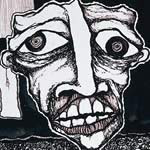"In every painting, as in any other work of art, there is always an IDEA, never a STORY. The idea is the point of departure, the first cause of the plastic construction, and it is always present all the time as energy creating matter. The stories and other literary associations exist only in the mind of the spectator, the painting acting as stimulus." --Orozco, from the pamphlet, The Orozco Frescoes at Dartmouth, 1934
In Bill Kartalopoulos's review of the eighth installment of the comics anthology Kramer's Ergot, he makes a case that the collection is acting as "an art-comics reflection on the networked age." If one agrees with Kartalopoulos's postulation, what makes the newest book by Dunja Jankovic interesting in this context is that she has managed to concurrently/independently (call it synchronicity, call it the zeitgeist of now) create a one-woman collection reflecting on this same topic: Circles Cycles Circuits.
What we're dealing with here is a collage comic book, which uses her own drawing in combination with photographic/found sources. Jankovic's book plays itself out along fine art lines that feel like a Fluxus work from the 1960s, and also brings to mind the Brion Gysin influenced collage work of William S. Burroughs from roughly the same era, placed in a comic book narrative context. Within comics, the most obvious connections would be Jack Kirby's "Negative Zone" collages from Fantastic Four (and interestingly, recent attention to his unpublished experimentation and looking at his work in context make the connection seem even more appropriate) and more recent work from Geoff Grogan.
If in the two issue Spakplug Comic Books series Department of Art/Habitat, Jankovic used her comics narrative to meditate on what it means to be an artist, searching for connection through expession in an isolated, perhaps dystopic society, the meditation implicit in Circles Cylcles Circuits is one that places the viewer right into a trip of experiencing consciousness itself. And, I would argue, a trip that is also a "reflection on the networked age." I use the word trip pointedly as this book feels, that is to say, it is psychedelic. And just as I invoked the Fluxus movement, the book does seem to conjure the aesthetics of the 1960s but using them to make a contemporary statement, as opposed to a nostalgia trip.
On this guided tour, circles are holes, sometimes literally in the paper, that beg us to look in, and look through, as sometimes that paper is transparent. Every passageway seems to be a transitation, and every moment we are asked as the viewer to focus, that focus opens up from micro to macro and closes back to micro, on something of a loop. At first we see a lone female in space. She is distorted and tumbles through it, unclear if she tumbles into inner or outer space, but before we're sure, it's time to look into a microscope. We are introduced to the case studies of Loretta, Sybille, Harpa, and Flora, describing their respective forays into consciousness/consciousness expansions in either the lingo of an advertisment or an advertisement pretending to be a clinical study (or maybe the other way around). But we're assured that "Efforts have been made to mould one's consciousness into a perfect shape for countless multidimensional travels." Which then puts us right back into space to be manipulated by Jankovic's expressionism which then dumps us, smack dab in the middle of the book, back into outer space again, but this time granted a mask. We put it on, adorned with her icongraphy. We are in it and a part of it, the book is telling us at the half way juncture.
It is here that the book takes on its most conventional, in terms of comics, narrative structure. We are told about the rituals of primitive cultures used to connect with the ineffable, to "become one, with the black and white..." We then transition into a first person account, the narrator, following the hole shaped facial injuries from photographs of plastic surgery: "I started cutting small geometrical shapes all over my body. Mostly circles." This leads to an account of the narrator, as teenager, exploring sexuality, expanding these holes as places to insert "metal plates and electromagentic chips in," building to at age 20 an ecstatic merging with the internet. This is, narratively speaking, the climax of the book, if you will allow me the pun. We go from there into uncharted territory of geometric shapes, images of 1950s women in ads, peasant folk dress, all culminating with us, our masks on regarding a similar visage on the paper as we look through the paper holes of our mask, a human face with her head exploding into a universal mind.
One can enjoy this work strictly for Jankovic's virtuoso visual flair and the top notch design of the book. But taking the trip on a narrative level, we're provided a non-linear but serious (if not seriously playful) rumination on consciousness in the digital age, done in between the covers of an exceptionally well-made paper product. And it reads to me like a logical extension of Jankovic's previous Sparkplug books. Those two books were some of the most exciting new discoveries in contemporary comics of recent memory, and I'm just as impressed with this offering. And like those books, here there seems to be implicit just as much possibility as there is confusion or fear in her worlds, or trips through her worlds. I have already returned, and I imagine myself returning, to Circles Cycles Circuits repeatedly to consider its mysteries. I'm willing to listen to Vera Suchanokova, "a fictional, yet alive character," and take on any confusion as a natural by product of the pangs of evolution, willing to trust Jankovic for no other reason than because her art is just that engaging.
